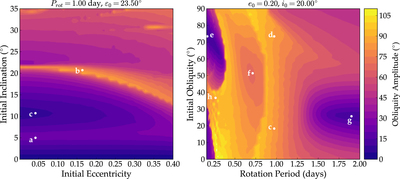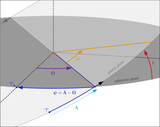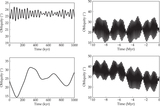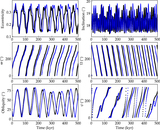Image Details

Caption: Figure 13.
Amplitude of the obliquity oscillation for the Earth-mass planet in TSYS, over two slices of our parameter space. On the left, we vary e0 and i0 at a fixed ﹩{P}_{\mathrm{rot}}=1﹩ day and ﹩{\varepsilon }_{0}=23\buildrel{\circ}\over{.} 5﹩. A strong secular spin–orbit resonance appears as a curved arc across this space. At the minimum obliquity oscillation on the lower left (point a), Cassini’s third law is satisfied. On the right, we vary the initial obliquity and rotation period at fixed ﹩{e}_{0}=0.2﹩ and ﹩{i}_{0}=20^\circ ﹩. Large-amplitude obliquity oscillations appear as bright yellow structures throughout this space. At points c and d, the motion of the obliquity is very similar to that at point b (see text). Minima appear at points e, f, g, which are “islands” of low-amplitude obliquity oscillations. Power spectra indicate that these Cassini-like states are associated with two of the dominant inclination frequencies.
Copyright and Terms & Conditions
© 2018. The American Astronomical Society. All rights reserved.












